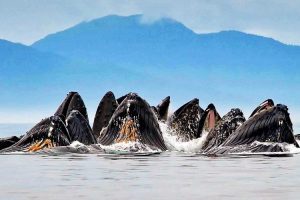Topics - Alaska
Alaska
Whales

Alaska is home to a large variety of whale species that either inhabit or migrate to its coastal waters, including Humpback, orca, fin, gray, blue, sperm and minke whales.1 Alaska’s peak whale season is in the early summer, when migratory whales have returned from their winter habitats nearer the equator. Whales are essential to the marine ecosystem and food chain, and without their presence the delicate system would fall out of balance.
Whaling has been practiced in Alaska for thousands of years, as many Native Alaskan Communities rely on whales for sustenance and cultural practices. Now, whaling is highly controversial and often criticized for being unsustainable, which discredits Indigenous Communities that have sustainably hunted whales for millennia. Subsistence whaling is a way of life for the Inupiat and Siberian Yupik people, and the tradition of whaling has been passed down through generations and continues to this day.2 A whale harvest in the Point Hope community can bring an average of 1.1 to 2 million pounds of food annually, which are freely shared by the fishermen.3 This not only ensures that community members have access to nutritious food, but also reduces the financial strain they can be put under if their food sources must be supplemented by high priced, non-nutritious food shipped in. Restoring whale populations to what they once were is not only important for the preservation of the species, but also to ensure that Native Alaskan communities can continue to rely on the culturally significant subsistence whale harvests.
While whaling can be done sustainably, respectfully, and can bring benefits to communities, it has not always been so. In the 1700 and 1800s, whale oil was a huge commodity due to its versatility, and as a result the American whaling industry boomed.4 Whaling became a multi-million-dollar industry, and more whales were hunted and killed in the early 1900s than ever before.5 Demand for whale oil decreased as petroleum, kerosene, and other products became more cost effective.
The whaling industry has since declined, and only three countries – Norway, Japan, and Iceland – still actively engage in commercial whaling.6 Some whale populations have stabilized and even partially recovered with the help of federal and international protections, but others are still declining. The overexploitation of whales in the 20th century continues to have modern day ramifications on whale populations, and when coupled with the impacts of the modern fishing industry and climate change, they have been pushed into endangerment, and in some cases, extinction. Continuing protections on whale populations that do not inhibit the abilities of Native Alaskans to hunt the species is essential for preserving both the species and the culture and lifeways of Native Alaskan Communities.
Sources:
- Available online from: https://www.alaskacollection.com/day-tours/kenai-fjords-tours/stories/everything-you-need-to-know-about-whales-in-alaska/ [accessed July 26, 2023].
- Available online from: https://www.aewc-alaska.org/ [accessed July 27, 2023].
- Available online from: https://iwc.int/management-and-conservation/whaling/aboriginal/usa/alaska [accessed July 27, 2023].
- Available online from: https://www.whalingmuseum.org/learn/research-topics/whaling-history/whales-and-hunting/ [accessed July 27, 2023].
- Available online from: https://education.nationalgeographic.org/resource/big-fish-history-whaling/ [accessed July 27, 2023].
- Available online from: https://sentientmedia.org/whale-hunting/ [accessed July 26, 2023].
CONNECT WITH US
Nikki Cooley
Co-Director
Nikki.Cooley@nau.edu
Karen Cozzetto
Manager
Karen.Cozzetto@nau.edu
Your tax deductible donation supports ITEP’s programming efforts.
Please contact us if you would like to contribute to our endowment or for any additional information regarding donations.

